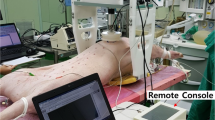Abstract
Eighty experiments were performed with nine awake dogs to study the changes of phasic pleural pressure with exercise. The increased minute volume with exercise was obtained by more frequent pleural pressure swings and by a substantial extention of the pressure swings in both directions. The cyclic changes of stroke volume following the pressure swings support the hypothesis that alterations of pleural pressure affect the stroke volume and can act, if necessary, as a secondary pump for the circulation. Mean pleural pressure during exercise fell by 2.5 cm H2O from the rest value of 12.1 cm H2O. The absolute right atrial pressure during exercise (−2.69 mm Hg) was not different from that at rest (−2.39 mm Hg). However, the transmural right atrial pressure of 7.6 mm Hg during exercise was higher than the pressure of 6.2 mm Hg at rest because during exercise the right atrium was perfused by 38% higher blood flow than that at rest. The phasic pattern of right atrial pressure shows that there is good reason to assume that during inspiration the extrathoracic veins are collapsed at their entrance into the chest, but this collapse is removed during expiration. There is no reason to assume an effective, sustained collapse of extrathoracic veins. Rather we can visualize a rythmical change of flow in extrathoracic veins from transient limitation to transient acceleration.
Similar content being viewed by others
References
Brecher, G.A.Venous Return. New York: Grune & Straton, 1956.
Bromberger-Barnea, B. Mechanical effects of inspiration on heart functions: a review.Fed. Proc. 40:2172–2177, 1981.
Cherniak, R.M., L.F. Farhi, B.W. Armstrong and D.F. Proctor. Comparison of esophageal and intrapleural pressure in man.J. Appl. Physiol. 8:203, 1955.
Guyton, A.C., A.W. Lindsay, B. Abernathy and T. Richardson. Venous return at various right atrial pressures and the normal venous return.Am. J. Physiol. 189:609–615, 1957.
Hoffman, L.A., T. Behrenbeck, P.A. Chevalier and E.A. Wood. Estimation of regional pleural surface expansile forces in intact dogs.J. Appl. Physiol. 55:935–948, 1983.
Hoffman, S.A., S.J. Lai-Fook, J. Wei and E.A. Wood. Regional pleural surface expansile forces in intact dogs by wick catheters.J. Appl. Physiol. 55:1523–1529, 1983.
Lai-Fook, S.J., K.C. Beck and P.A. Southorn. Pleural liquid pressure measured by micropipettes in rabbits.J. Appl. Physiol. 56:1633–1639, 1984.
Permutt, S. and R.A. Wise. Mechanical interaction of respiration and circulation.Handbook of Physiology 3. New York: Am. Physiol. Soc., 1986, Vol. III, pp. 647–656.
Schrijen, F., W. Ehrlich and S. Permutt. Cardiovascular changes in conscious dogs during spontaneous deep breath.Pflügers Arch. 355:205–215, 1975.
Wiener Kronish, J.P., M.A. Gropper and S.J. Lai-Fook. Pleural liquid pressure in dogs measured using a rib capsule.J. Appl. Physiol. 59:597–602, 1985.
Wirtz, K. Das Verhalten des Druckes im Pleuraraum bei der Atmung und die Ursachen seiner Veränderlichkeit.Pflügers Arch. 199:1–56, 1923.
Author information
Authors and Affiliations
Rights and permissions
About this article
Cite this article
Jayaweera, A.R., Ehrlich, W. Changes of phasic pleural pressure in awake dogs during exercise: Potential effects on cardiac output. Ann Biomed Eng 15, 311–318 (1987). https://doi.org/10.1007/BF02584286
Issue Date:
DOI: https://doi.org/10.1007/BF02584286




